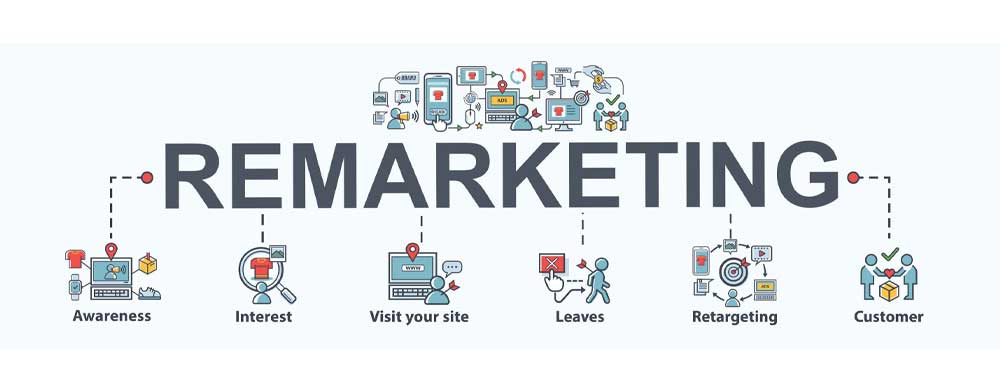A recent report by Forrester shows that 96% of site visitors leave without completing the desired action. And that 70% of visitors who add products to their online shopping carts leave midway before checking out. If this report is anything to go by, then there’s a need to lure these visitors back and get them to complete the desired action. That’s where online remarketing comes in.
Online remarketing is a tactic that involves placing ads in front of a person who previously visited your website or mobile application but didn’t convert. It is a cost-effective way to boost sales conversion because you’re reaching out to an audience that has already shown interest in your solutions or products. Think of online remarketing as a way of providing your visitors a second or third chance to become customers. It is a strategic component of your digital marketing efforts, particularly when looking to increase registrations, drive sales or promote your brand.

A real-world example
So let’s say you run a jewelry shop in a mall. A client walks in to sample your latest collections and ends up loving a necklace. She grabs it and heads towards checkout, only for her son to bolt out of the shop and disappear into the mall. Expectedly, the client puts down the necklace and runs after the son, shouting at the top of her voice. When she finally finds him, she’s probably done with the mall and heading home.
It has nothing to do with your necklace not meeting her expectations. Were it not for the distraction; she would have bought the necklace. But sadly for you, this client may be lost forever because there’s really no way to remind her she wants to buy the necklace.
It’s slightly different online
The story is a little different online. You own the same jewelry shop and have a website or an app for your online audience. The client finds the necklace she was looking for in your catalog and adds it to her cart. She – like 49% of other consumers –decides to compare prices with your competitors before checkout. But right in the middle of the process, she gets distracted by an email or call and ends up forgetting about the necklace.
So you end up missing out on a potential sale, yet again. Only this time, there’s a way to bring this client back and get her to checkout. Online remarketing.
Remarketing allows you to target your ad to her so that the next time she’s online, she sees a great deal on the necklace. The necklace plus the discount (like free shipping) will most certainly capture her attention and get her to buy the necklace. If you are lucky, she might end up purchasing other products too, while taking advantage of the offer – and that’s a huge win for remarketing. Remarketing lets you stay in front of those who leave while they make up their minds. It gives you insights into various aspects, including when prospects visit your site, how long they stay, what they look at, whether he or she places something in their cart, and the number of times they come back.

Types of online remarketing
There are different ways to bring back those clients that leave your site without converting. Let’s look at the four most popular options for remarking to prospects.
Email remarketing
The idea that 70% of online users engage with your website to the point where they’re about to check out, but end up leaving is heart-wrenching. But cart abandonment is a natural part of the buying cycle. In fact, you can look at it as a conversion rate optimizer and an opportunity to service your customer. Customers give you an excellent purchase intent signal when they leave midway. Email marketing is like your second or third chance. It allows you to continue the conversation with your prospects. A quality email remarketing strategy will either help you:
- Win the order 10 to 15% of the time
- Know why the prospect didn’t buy
- Create a positive emotional connection with prospects
- Create a good customer service moment and leave a lasting impression on the prospect
In addition to cart abandonment, email remarketing also includes emails sent for cross-sells/upsells and lifecycle marketing.
Google remarketing
Google remarketing lets you run remarketing campaigns on the Google Display Network. This includes Google Search Network, YouTube, and Gmail Sponsored Promotions. To get started with Google remarketing, you’ll need to add a code known as a pixel or tag to your site. This will add your visitors to your remarketing audiences through browser cookies.
Remarketing lets you display ads to people who have previously visited your site or app. But there’s also dynamic remarketing, which takes it a notch higher. Dynamic remarketing allows you to show previous visitors ads that contain products or services they’ve seen on your site. With ads customized to your audience, dynamic remarketing helps you create leads and sales by re-engaging visitors so they can complete what they started.

When you present your retargeted ads to people who have already visited your site, you give them the impression that you are a reputable brand. The fact that these people see your brand as they browse other parts of the web makes them more inclined to trust and buy from you. Studies show that brand affinity dramatically impacts the click-through rates up to 2-3x. Thus, remarketing ads have a higher CTR and conversion rates than typical display ads.
Social media remarketing
Social media remarketing works more or less like Google remarketing. The only difference is once you gain insights into the user’s behavior and needs, you now create remarketing ads campaign that displays on their social pages. Platforms like Twitter and Facebook let you create ads campaign and show them to your target audience in their news feeds.
Video remarketing
You can display customized ads to millions of viewers on platforms like YouTube and Google partner sites. Like email and Google remarketing, these ads should be based on the viewers’ past interactions with your videos on these platforms. When you reinforce your campaign with an audience that has already viewed your channel or video, you’re highly likely to increase your ROI.
To create your remarketing list, you’ll need to link your channel to your Google Ads account. You can then build lists that get to prospects who have taken any of the following actions on YouTube:
- Subscribed to a channel
- Shared any video
- Viewed specific videos (as ads)
- Viewed any video from a channel
- Viewed creating videos
- Visited a channel homepage
- Added any video from a channel to a playlist
- Liked any video from a channel
You can link all of these actions from your channels to your Google Ads account. It’s possible to create multiple lists per channel, but you can’t use the same list on various channels.
Why is online remarketing important
By now, you already know that a majority of those who visit your website or app won’t buy on the first visit. You also know that you can increase your site’s conversion rate overall by adopting remarketing strategies that bring prospects back again. You may not know yet that digital remarketing helps you increase your brand awareness and that it portrays you as an authority in your market. The more times your prospects see an ad, the more significant the impact it will make. This is a typical course of action many of the top ecommerce businesses take on a daily basis. Find out how Valid Resource can help you get the most out of your remarketing efforts.
Schedule a call with us today!




